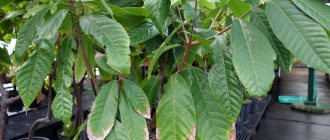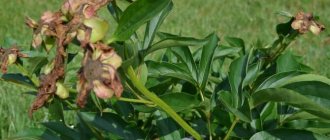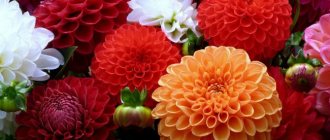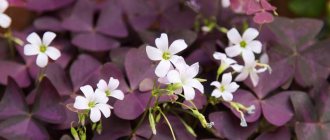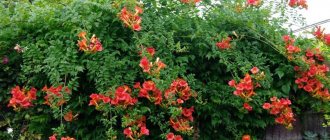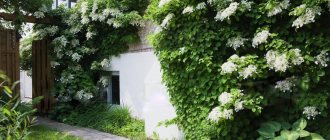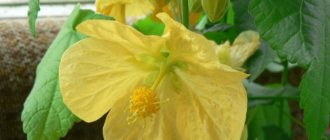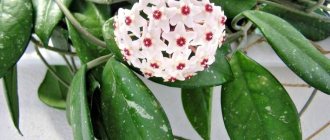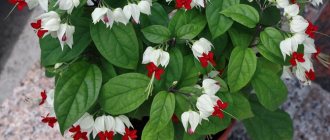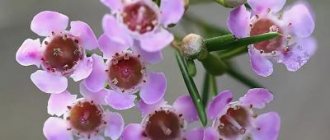Clerodendrum Ugandan grows not only in the Rwenzori Mountains, which rise in the western part of East Africa, but also decorates the window sills of apartments and country houses in mid-latitudes.
The tropical plant is called the tree of destiny. There is a legend that it brings good luck and happiness.
The leaves and flowers of almost all types of shrubs and vines that occupy their place in the Verbenov family have a unique and not very pleasant aroma.
Botanical description
An evergreen vine with vines up to 2.5 m. The shoots are thin and become woody over time. Leaves on short petioles, dark green. The shape is wide, lanceolate with a smooth or slightly serrated edge. The leaves are arranged oppositely on the stem.
Blooms for a long time - from spring to autumn. The flowers are small, five-petaled, and shaped like butterflies. Four petals are painted in a delicate blue color, the fifth is blue. The stamens are long and curved. The inflorescences are paniculate, loose, and form on young shoots in the leaf axils.
In southern regions with a warm climate, Ugandan clerodendrum can be grown in open ground. In the middle zone, it cannot withstand winter cold even under good shelter.
Types and varieties of clerodendrum
Wallich's Clerodendrum or Prospero (Clerodendrum Prospero), which is also called “Cleopatra's tears”. The most capricious species to grow comes from Bangladesh, India and southern China.
It received its name in honor of the Danish botanist and explorer Wallich Nathaniel, who discovered this species while participating in scientific expeditions to India.
The height of the plant is about half a meter. Its characteristic feature is large shiny dark green, leathery leaves with wavy edges about 15 cm in length. Numerous snow-white flowers are collected in drooping clusters. Wallich Nathaniel was delighted by the exotic beauty of Clerodendrum Prospero.
Thompson's clerodendrum (Clerodendrum thomsoniae). The most common species in indoor culture comes from West Africa. It got its name in honor of the missionary priest and doctor William Cooper Thomson, who spent a lot of time in Nigeria. The elastic shoots of the evergreen vine are covered with large leaves with visible veins.
The flowers are bright red tubular, surrounded by snow-white, pink or pale purple or red bell-shaped petal bracts, collected in racemes of loose inflorescences.
In addition to the magnificent flowering of this species, there are decorative deciduous hybrids of the "Variegatum" group with marble-green foliage that complements the beauty of the flowers.
Clerodendrum variegata
Popular and showy variety 'Delectum' with pink-purple flowers in very large inflorescences, 'Bleeding Heart Vine' with bright red blooms.
Ugandan Clerodendrum is native to the mountainous regions of East Africa. One of the most famous species, often called the “Blue Butterfly” due to the special shape of the flowers.
The plant is a fast-growing vine about 2 m long. The inflorescence consists of 5 flowers of a pale blue or purple hue. The pruning procedure allows you to form a bush shape.
Clerodendrum speciosum is another member of the genus, native to Polynesia and New Guinea.
It is a bush with scarlet flowers and pink bracts, blooming profusely throughout the summer.
Philippine clerodendrum (C. philippinum). A fast-growing shrub species that is easy to care for and blooms already in the 2nd year of life.
Characterized by beautiful large double flowers with a strong jasmine aroma with hints of vanilla.
Clerodendrum Schmidtii (C. schmidtii) is a shrub or small tree with several stems and drooping shoots.
White fragrant flowers cascading in loose long inflorescences. Fully open, the flowers resemble white butterflies.
Flower stems are dark red.
Flowering occurs mainly in winter.
Can be grown both on a trunk and in hanging pots.
Clerodendrum inerme. A hardy, branching shrub with long flexible shoots, reaches a height of 3 meters in its natural habitat, but at home the height is controlled by pruning. Well suited for growing bonsai.
The leaves are almost round and shiny. The plant blooms almost all the time. The flowers are white and very fragrant, with long purple stamens. There is also a variegated form of the plant with golden-green leaves.
Clerodendrum splendens is an evergreen woody vine growing up to 3 - 4 m in length.
The leaves are large, ovate, shiny, panicle inflorescences are 12-15 cm in diameter, and consist of bright scarlet flowers. Blooms almost all year round.
Clerodendrum Bunge (C. Bungei). A low bush with large, unpleasantly smelling, ovoid leaves.
Young leaves often have a purple tint.
"Pink Diamond"
Fragrant pink flowers are collected in a round inflorescence. Popular variety with variegated foliage: 'Pink Diamond'. Blooms from late summer and throughout autumn.
Caring for Ugandan clerodendrum: what to consider
How to care for Ugandan clerodendrum in a pot? Like any tropical crop, it has certain microclimate requirements. You can’t call it capricious, but in unfavorable conditions and with improper care, clerodendrum will not bloom. Experienced flower growers recommend adhering to the following rules.
- Temperature. In summer there is no need to create special conditions. Clerodendrum feels great at an average room temperature of 20-25°C. Difficulties may arise in winter - lower temperatures of 12-16°C are required. Small young plants can be moved closer to the window glass or fenced off from the room with a thick curtain. Adults - take it to a glazed, insulated balcony.
- Lighting. The need for light is high. Place in a well-lit place with minimal direct sunlight. During the day, when it’s hot, be sure to provide some shade—the leaves quickly become sunburned. On the north side it lacks light, stretches out, and does not bloom. If there are no other options, organize artificial lighting with phytolamps or fluorescent lamps.
- Watering. Ugandan clerodendrum needs to be watered systematically. The amount of watering depends on the time of year and temperature. In summer, water abundantly, in winter - moderately. Use well-settled, soft water at room temperature. It reacts instantly to drying out of the soil - the leaves wither, droop, and begin to fall off. If the drought was short-lived, after watering the leaves become elastic again.
- Humidity. Systematic spraying is an important condition for active growth and maintenance of decorativeness. Air humidity is above average. It is artificially increased by placing a pot with a flower in a tray filled with wet expanded clay. Spray every day with soft water with a minimum salt content.
- The soil. The soil mixture is prepared from peat, turf, coarse sand, deciduous soil and humus. Mix in equal proportions. You can use ready-made substrates. The main thing is that the soil is light, breathable, and sufficiently nutritious.
- Transfer. Refers to fast-growing crops. Young plants have to be replanted twice a year - in autumn and spring. Adults are replanted once a year. In large specimens, you can simply replace the top layer of soil. A drainage layer is required.
- Feeding. Fertilizers are applied during the period of active growth. You can fertilize Ugandan clerodendrum with a standard preparation for flowering crops. They have an increased content of phosphorus and potassium - important microelements for flowering. When the clerodendrum fades and begins to go into hibernation, stop feeding.
Growth activity can be adjusted by the size of the pot and the composition of the fertilizer. The larger the pot and the more nutritious the soil, the faster the clerodendrum will gain green mass. For moderate growth, the new pot should be only 3 cm larger than the previous one.
Difficulties in growing
With the right conditions at home and proper care, Ugandan clerodendrum will delight you with beautiful flowering. But if some mistakes were made in care, then some problems may arise during cultivation.
The most common problems and how to deal with them:
- Clerodendrum does not bloom - lack of sunlight. It is necessary to move the pot to a brighter place.
- Leaves fall - the air in the room is too dry. Regular watering and spraying of the shoots will help.
- Pale leaves with dry tips indicate too hard water. Use filtered water for irrigation.
- There are brown spots on the leaves - the room is too cold. It is necessary to move the flower to a warmer place.
Did you know? On the island of Java there is a belief that clerodendrum brings good luck to young girls and women, and on the African continent it is used in wedding ceremonies.
Why doesn't it bloom
The reason that clerodendrum does not bloom may be a room that is too dark or cold, a lack of fertilizer, or improper pruning. The inflorescences appear at the tops of the shoots; if excessive pruning occurs, the flower stalks can also be removed. The key to lush flowering is a mandatory 2-3 month rest period in late autumn - early winter, at a temperature of +15°C. After rest, the clerodendrum will bloom to its full potential.
Diseases and pests
If you water too much or have poor drainage, clerodendrum can develop root rot. The root system affected by the disease rots and the plant may die. It is necessary to remove the affected roots, replant the flower in fresh, disinfected soil and do not overwater it in the future. Clerodendrum leaves contain essential oils that repel many insects.
But still he has enemies who can cause harm:
- spider mite – a thin cobweb appears on the leaves, they turn yellow and fall off;
- whitefly – on the inside of the leaves there are many small white flies, about 2 mm long, they feed on the sap of the plant. The leaves turn pale, yellow spots and small holes appear on them;
- aphid – the plant grows poorly, the buds and shoots curl, there are small insects on the inside of the leaves.
A warm shower and treatment with an insecticide such as Actellik or Microcin will help destroy pests on the leaves.
Find out more about other types of clerodendrum: Philippine and Thompson.
So, we can conclude that caring for a tropical “tree of destiny” is no different from caring for most indoor plants. Anyone can grow this magnificent flower, provided that they have a bright and warm corner at home. It is enough to follow all the recommendations and avoid gross mistakes in care, and your home will be filled with the pleasant aroma and beauty of blue butterfly flowers all summer long.
Pruning rules
Growing clerodendrum at home is complicated by the need for regular pruning. Without pruning, clerodendrum will quickly grow vines and foliage, but will stop blooming. Clerodendrum Ugandan pruning begins early. On small young bushes you can simply pinch off the growing points. In subsequent years, it is recommended to trim the vines to a third of their length.
Pruning is carried out in early spring before the start of active growth or in the fall before entering the dormant period. Here flower growers have different opinions. Typically, shoots are cut to a third of their length. If the clerodendrum is formed in the form of a compact bush, they can be shortened by half. Clerodendrum tolerates pruning easily. After some time, new side shoots actively begin to grow. It is on them that the buds are formed.
It is possible to form clerodendrum in the form of a small standard tree. They start working with a young plant - mature bushes are more difficult to shape. This is done simply. One strong shoot is left, the rest are cut out at the root. Upon reaching a height of half a meter, the growth point is pinched and the shoot is tied to a straight vertical support. The lower part of the stem is exposed, the remaining branches are pinched. Regular pinching ensures the formation of a lush, even crown.
How to grow?
Almost all varieties of pachypodium have increased tolerance to unfavorable climatic conditions, so caring for it at home is not difficult. The plant does not require watering, is not afraid of direct sunlight and does not need regular feeding. Despite the fact that the maintenance of a flower is simple, this does not mean that it does not need to be looked after at all.
It is recommended to place a pot with a houseplant on a windowsill facing south. If the apartment or house does not have windows facing south, then it is placed in the east direction. It is worth noting that the ornamental shrub can grow well in partial shade, the only thing is that under such conditions it will begin to lose its beauty and its shoots will become elongated.
The flower can easily adapt to both room and street temperatures; in summer it should exceed +30ºС. If the plant grows in a room, then in hot weather it can be taken out to the balcony or loggia
When growing shrubs in the garden, it is important to choose a suitable place so that it is protected from drafts. In addition, the street flower will have to be transplanted into a large pot in the fall, since air temperatures below +15ºС are considered critical for it
When hypothermia occurs, the foliage on the top of its head begins to turn black and the trunk becomes soft.
As for watering, pachypodium loves moderate humidity, an excess of which can destroy the plant. Therefore, when growing, it is necessary to find a “golden mean” so that the soil is not too dry and wet. You need to water the flower with pre-settled water at room temperature.
Under natural conditions, ornamental bushes grow on rocky and sandy soils, which are poor in nutrients, so frequent application of fertilizers can negatively affect their development at home. Experts recommend feeding the flower with small portions of microelements in spring and summer, while the use of organic compounds and manure is strictly prohibited.
Many varieties of pachypodium are characterized by slow growth, since their growth per year is no more than 5 cm. Thanks to this, the plant does not need to be replanted often. Young shrubs, as they grow, 1–2 years after planting, are moved to larger containers, which will last them for another 3 years. It is advisable to transplant in early spring or autumn before the onset of cold weather.
It is best to purchase soil for replanting (planting) plants in stores; it should be intended only for succulents and cacti. If desired, you can prepare the planting substrate yourself by mixing brick chips with charcoal, sand and turf soil.
Since this type of plant has needles on its trunk, when replanting it you can encounter a huge problem. In order not to injure your hands and to protect yourself when further caring for the flower, the thorns must be trimmed with sharp scissors. After this, the plant is carefully removed with a lump of earth from the old pot and carefully placed in a new container. Often, when planting, pachypodium roots can break, so you need to be careful with them.
If it doesn't bloom: 4 reasons
Ugandan clerodendrum does not bloom due to unsuitable conditions. The temperature regime during wintering, the frequency of fertilizing and the composition of fertilizers, and the method of formation have an effect. There are four main reasons for lack of flowering.
- Clerodendrum is not pruned. After pruning, side shoots begin to grow, on which buds form. The more young shoots a plant has, the more abundant the flowering.
- Big pot. In a spacious pot, clerodendrum begins to intensively grow vines. Flowering is inhibited.
- Wrong fertilizer composition. The nitrogen content in the complex fertilizer should be minimal. Potassium and phosphorus - increased.
- Warm wintering. A warm winter does not affect its appearance. But flower buds are formed only when kept cold.
They stimulate the flowering of Ugandan clerodendrum by creating coolness in winter, minimizing watering, and replanting it in a small, slightly cramped pot. In the spring, the plant is returned to warmth and the intensity of watering is increased. With the appearance of buds, the first feeding is carried out.
Caring for Ugandan clerodendrum during flowering consists of regular feeding and timely removal of individual wilted flowers and peduncles. Do not allow the soil to dry out and protect the clerodendrum from drafts.
Home care
Tropical clerodendrum is planted in rooms and heated loggias. The evergreen perennial loves the sun and does not suffer from direct hot rays. The creeping vine develops quickly.
At home, it is formed in the form of a tree, hanging plant or bush, but clerodendrum will delight you with blue flowers hovering like butterflies above the leaves only if you have:
- bright light;
- high humidity;
- a certain air temperature;
- abundant watering.
The tropical liana is not disturbed by the hot rays of the sun and heat, but in winter the plant will rest well and gain strength if the room temperature is no more than 16 and no less than 12 °. If the temperature regime is not observed, clerodendrum will not please you with its lush color .
Reproduction methods
The easiest way to propagate Ugandan clerodendrum is by cuttings. The apical shoots take root easily in water or soil. Seed propagation is also allowed, but you will have to wait much longer for the first flowering. In both cases, the propagation technique is simple and effective.
- By cuttings. The apical cuttings remaining after pruning can be rooted. They are placed in water with the addition of activated carbon tablets or immediately dropped into light, damp soil. To speed up rooting, treat the cut site with a root formation stimulator. Common drugs are “Heteroauxin”, “Kornevin”. When rooting in the ground, the cuttings are covered with a plastic cup or a cut balloon.
- Seeds. Seeds are sown at the end of winter in a sand-peat mixture. Any loose, light soil can be used. Sprout under cover. The greenhouse is ventilated daily and the soil is moistened with a spray bottle as needed. Seedlings dive into separate cups after the appearance of the fourth true leaf.
It is better to start shaping as early as possible. It does not harm clerodendrum - on the contrary, it stimulates its growth. The sooner formation begins, the faster the first flowering will occur.
Diseases, pests, growing problems
Clerodendrum leaves do not have a strong, but specific odor, so pests practically do not touch it. If the air in the room is very dry, they are affected by spider mites, whiteflies, and aphids. You have to deal with scale insects less often.
Common fungal and infectious diseases of indoor plants avoid clerodendrum. The exception is rot - the root system can rot as a result of excessive watering and lack of drainage. Most problems are related to care errors. The main diseases and methods for eliminating them are given in the table.
Table - Problems of growing Ugandan clerodendrum
| Problem | Probable Causes | Solution |
| Leaves turn yellow | — Problems with roots; - dry air; - lack of light; - lack of nutrition | — Adjust the care regimen |
| The tips of the leaves become dry | — Low air humidity; - sunburn | - Spray regularly; - protect from direct sun |
| Clerodendrum sheds its leaves | — Soil drying out; - damage to the root system | — Regulate the watering regime; - if there is a problem with the roots, replant |
| Spots appear on leaves | - Sunburn; - leaf chlorosis; - cold draft | — Place in a place protected from the sun and drafts; - in case of chlorosis, spray with iron-containing preparations |
| The leaves turn black | — Watering with concentrated fertilizer on dry soil; - rot of the root system | — Transplanted into fresh soil; - damaged roots are removed |
| The flower droops between waterings | — Small pot volume | - Transplanted into a larger pot |
How to care for Ugandan clerodendrum in order to constantly maintain its decorative effect? The main requirements are regular watering, timely fertilizing, observance of a dormant period, pruning and protection from the sun. These simple rules will help you grow a beautiful clerodendrum and achieve lush flowering.
Pests and diseases
The unpleasant smell of tropical vines comes from essential oils present in large quantities in the leaves, which drives away many insects from the plant. Not afraid of a specific aroma:
- whiteflies;
- scale insects;
- aphids and mites.
Advice! When pests appear, the clerodendrum should be washed with warm water and sprayed with a fungicide.
A perennial gets sick when care requirements are ignored. The leaves wither and turn yellow if the soil under the plant dries out. When there is a lack of moisture, the buds fall off. Drafts and cold provoke the formation of black spots on stems and shoots.
Important! Despite the fact that the vine loves the sun, hot rays can cause burns on the foliage. It takes on a brown tint.
